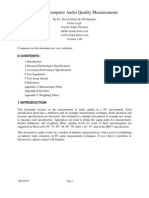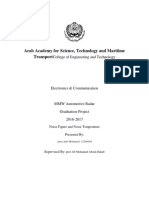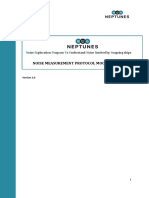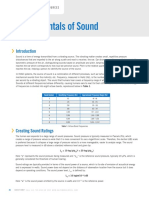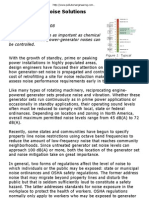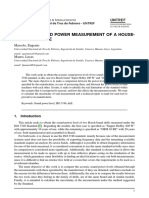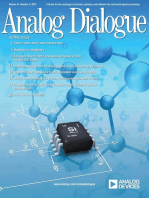Characteristic Values For Noise Emission and Standards For Measuring Them
Characteristic Values For Noise Emission and Standards For Measuring Them
Uploaded by
Praveen Manikandan MuthurajCopyright:
Available Formats
Characteristic Values For Noise Emission and Standards For Measuring Them
Characteristic Values For Noise Emission and Standards For Measuring Them
Uploaded by
Praveen Manikandan MuthurajOriginal Title
Copyright
Available Formats
Share this document
Did you find this document useful?
Is this content inappropriate?
Copyright:
Available Formats
Characteristic Values For Noise Emission and Standards For Measuring Them
Characteristic Values For Noise Emission and Standards For Measuring Them
Uploaded by
Praveen Manikandan MuthurajCopyright:
Available Formats
Characteristic values for noise emission and
standards for measuring them
Characteristic values that describe noise emission
To describe the noise emitted by a machine, the following characteristic values are of particular
importance, as they describe the noise directly emitted independently of extraneous noise and
of the room in which it is housed.
Emission sound pressure level at the workplace Lp: This is a measure of the sound pres-
sure level caused by the machine at its workplace independently of room-related effects or
extraneous noise. It is thus equivalent to the sound pressure level at the workplace if the
machine is set up outside in a silent environment (ideal case).
Sound power level LW: This is a measure of the total sonic energy directly emitted by the
machine per unit of time.
The relationship between the sound pressure level and sound power level is relatively easy to
represent for a machine under free field conditions (unhindered sound propagation) and without
any appreciable extraneous noise. The sound power level LW can then be calculated from the
mean sound pressure level Lp on a measuring surface enclosing the machine and from the
measuring surface area S by means of the following formula:
LW = Lp + 10 lg (S/1 m²) dB or (1)
LW = Lp + LS dB (2)
Where: Lp = mean sound pressure level on measuring surface S
S = measuring surface area
LS = 10 lg (S/1 m²) – measuring surface dimension (3)
Figure 1 shows an example of a measuring surface S with five measurement points for deter-
mining the sound power level. The measurement distance d from the machine surface (refer-
ence box) is usually defined as 1 m.
Under these special conditions (free field and no extraneous noise), the sound power level
therefore only differs from the mean sound pressure level Lp on the measuring surface
by the so-called measuring surface dimension LS = 10 lg (S/1 m²). The measuring surface
dimension LS can be calculated with Formula 3 from the measuring surface area S or simply
read off the diagram in Figure 2.
Characteristic values for noise emission (September 2011) Page 1 of 4
Figure 1: Example of a
measuring surface with five
measurement points for a
small machine (l1 ≤ d, l2 ≤ d, l3
≤ 2 d) for determining the
sound power level in accor-
dance with DIN EN ISO 3746
Figure 2: Measuring surface
dimension LS as a function of
measuring surface area S
Since the emission sound power level at the workplace is in many cases of the same
magnitude as the mean sound pressure level on the measuring surface, the difference between
the emission sound pressure level and the sound power level is similar. Experience shows that
the emission sound pressure level Lp of a machine is roughly 8 to 25 dB below the
corresponding sound power level LW – depending on the size of the machine, the directional
characteristics of the emitted sound and the position of the workplace measurement point.
Characteristic values for noise emission (September 2011) Page 2 of 4
While the sound power level is usually the most important noise parameter for the purchaser of
a machine, occupational safety and health professionals tend to be more interested in the
emission sound pressure level at the workplace because the latter value is of the similar mag-
nitude as the sound pressure level anticipated at the workplace. It may also make sense to
choose a machine A with a slightly higher sound power level than machine B if machine A has
a lower sound emission in the direction of the workplace and hence a lower emission sound
pressure level.
Noise emission information
Under the EC Machinery Directive 2006/42/EC, the manufacturer or seller of a machine is obli-
gated to state the machine’s noise emission in the user’s manual and sales brochures. What is
firstly required as the characteristic value for noise emission is the emission sound pressure
level at the workplace LpAd. Only in the case of levels LpAd exceeding 80 dB(A) does the sound
power level LWAd also have to be given, as shown in Table 1. In the case of emission sound
pressure levels up to 70 dB(A), the information “70 dB(A)” is sufficient without details of the
actual noise emission.
Table 1: Noise information required under the EC Machinery Directive depending on the emission sound pressure
level Lpd
Lpd Required noise information
Characteristic value for noise emission Quoted value
70 dB(A) Emission sound pressure level LpAd = 70 dB
at the workplace
or
LpAd = … dB
> 70 dB(A) Emission sound pressure level LpAd = … dB
at the workplace
> 80 dB(A) Sound power level LWAd = … dB (re 1 pW)
and and
emission sound pressure level
at the workplace LpAd = … dB
LpCpeak > 130 dB Peak sound pressure level LpCpeakd = … dB
In addition to the measured characteristic value for noise emission (LWA or LpA), the uncertainty
K associated with this also has to be stated. This uncertainty K takes account not only of the
uncertainty of the measuring method, but also of the uncertainty inherent in the statistical
spread of a machine batch in production and is usually specified by the associated standard for
the specific machine. Table 2 presents an example of the noise values given in accordance
with the Technical Rule for the Noise and Vibration Ordinance (TRLV Lärm).
Characteristic values for noise emission (September 2011) Page 3 of 4
Table 2: Correct noise information with numeric values given by way of example (example from “TRLV Lärm”)
Machine type, performance data, operating conditions
Dual noise emission values in accordance with DIN EN 4871 Idling Under load
A-weighted sound power level LWA in dB re 1 pW 94 98
Uncertainty KWA in dB 2 2
A-weighted emission sound pressure level LpA
in dB re 20 Pa at operator’s workplace 80 86
Uncertainty KpA in dB 2 2
The values were obtained in accordance with noise test standard DIN EN ISO xxx with the application of the
basic standards DIN EN ISO 37xx and DIN EN ISO 1120x.
Because this noise information means little to many purchasers of machines and the stated
numeric value alone says nothing about the noise emission compared to other machines of the
same design, the possibility of presenting this information in noise classes, e.g. A, B and C, or
in colours from green via yellow to red, as familiar from the energy consumption of household
appliances, is currently under discussion (see, for instance, the International “Buy Quiet”
Symposium, Paris, 5th to 6th July 2011). One way of drawing attention to a particularly low-noise
product and of promoting it on the market is by displaying a suitable symbol, such as the
German “Blue Angel” awarded by the Federal Environment Agency.
Standards for determining emission characteristic values
Among the standards for the measurement of noise emission, a distinction can be made
between the basic standards, each of which describes in general the measurement strategy for
ascertaining the emission sound pressure level or sound power level, and, based on these, the
standards for specific machines (noise test code). The noise test codes define the installation
and operating conditions (rpm, load ...) to be achieved for the various machine categories at
measurement. The measurement of the emission sound pressure level at the workplace is
described in basic standards DIN EN ISO 11201 to DIN EN ISO 11205. To determine the
sound power level, the main basic standards of importance are DIN EN ISO 3744 and
DIN EN ISO 3746. Depending on the machine type and the usual installation conditions, other
basic standards can also be meaningfully applied to ascertain the sound power level.
A complete overview of the basic standards for determining the characteristic values for noise
emission is given, for instance, in the paperback “Lärmmessung im Betrieb” (in German). The
publication describes the associated measurements in detail and explains them with reference
to examples.
Author: Dr. Jürgen Maue, Institut für Arbeitsschutz der Deutschen Gesetzlichen
Unfallversicherung (IFA), Sankt Augustin
Characteristic values for noise emission (September 2011) Page 4 of 4
You might also like
- JBL Audio Engineering for Sound ReinforcementFrom EverandJBL Audio Engineering for Sound ReinforcementRating: 5 out of 5 stars5/5 (2)
- Marine Diesel Engine and NoiseDocument8 pagesMarine Diesel Engine and NoisepawanNo ratings yet
- Acoustic MeasurementsDocument14 pagesAcoustic MeasurementsShivjyoti MohapatraNo ratings yet
- Audio MeasurementDocument31 pagesAudio MeasurementBing HanNo ratings yet
- Silencer DimensioningDocument14 pagesSilencer DimensioningAntonioVirardiNo ratings yet
- Arab Academy For Science, Technology and Maritime TransportDocument17 pagesArab Academy For Science, Technology and Maritime TransportAnas ElmahdyNo ratings yet
- Noise Measurements, Standards and Control TechniquesDocument42 pagesNoise Measurements, Standards and Control TechniquesPrabhu PrasadNo ratings yet
- NoiseDocument27 pagesNoiseSami UllahNo ratings yet
- VU Meter Myths. Best Practices in Getting The Clean SoundDocument6 pagesVU Meter Myths. Best Practices in Getting The Clean SoundFrancesca OrtolaniNo ratings yet
- Noise Measurement Protocol V2 1Document30 pagesNoise Measurement Protocol V2 1khem samrithNo ratings yet
- Fantech - Noise & AcousticDocument2 pagesFantech - Noise & Acousticmoh khNo ratings yet
- Receiver Noise Figure MeasurementDocument13 pagesReceiver Noise Figure Measurementعلی بنائیNo ratings yet
- Fundamentals of SoundDocument26 pagesFundamentals of SoundmishraenggNo ratings yet
- How To Measure LDO NoiseDocument9 pagesHow To Measure LDO Noisesanjeevsoni64No ratings yet
- Glass and Acoustic InsulationDocument5 pagesGlass and Acoustic InsulationAnonymous vQewJPfVXa100% (1)
- Sound Level TestDocument12 pagesSound Level TestShajib RahmanNo ratings yet
- DB (A) Information: Noise Levels - Calculation and Use of The DB (A)Document2 pagesDB (A) Information: Noise Levels - Calculation and Use of The DB (A)rekaman padmasejatiNo ratings yet
- Genset Noise SolutionDocument7 pagesGenset Noise Solutionroni15100% (1)
- Sound Pressure Calculation - AC - Rev1Document4 pagesSound Pressure Calculation - AC - Rev1indalfNo ratings yet
- Quantization and Thermal Noise - ADC Noise FigureDocument5 pagesQuantization and Thermal Noise - ADC Noise FiguregsnaveenNo ratings yet
- Industrial Noise ControlDocument19 pagesIndustrial Noise ControlSantiago IsazaNo ratings yet
- Module 4 CEE335Document38 pagesModule 4 CEE335Anonymous aE0YYlCOKNo ratings yet
- Clayton Horse Creek Noise Ch2mhill 05030Document29 pagesClayton Horse Creek Noise Ch2mhill 05030pandorasboxofrocksNo ratings yet
- Acoustical Data Fcu EuroventDocument0 pagesAcoustical Data Fcu Euroventsiva_nagesh_2No ratings yet
- Air Cooled Head Exchagers - Axial FansDocument20 pagesAir Cooled Head Exchagers - Axial FansVILLANUEVA_DANIEL2064No ratings yet
- Understanding Noise Figure: PDF VersionDocument12 pagesUnderstanding Noise Figure: PDF VersionFahim Ahmed AbbasiNo ratings yet
- Integrating Sound Level Meter: Measuring Sound Levels in Free Field ConditionsDocument19 pagesIntegrating Sound Level Meter: Measuring Sound Levels in Free Field ConditionsECRDNo ratings yet
- Est Signal To NoiseDocument21 pagesEst Signal To NoiseGiovanniNo ratings yet
- Acoustic Sound Power Measurement of A DrillDocument15 pagesAcoustic Sound Power Measurement of A DrillEugenio MassoloNo ratings yet
- Spectrun Analysis 8554-8447Document24 pagesSpectrun Analysis 8554-8447symasiNo ratings yet
- NIST LinkBudgetCalc 2 4Document13 pagesNIST LinkBudgetCalc 2 4yaro82No ratings yet
- Sound Power Determination With or Without IS09614-1: by Erik Cletus Petersen, Bruei&Kjser, DenmarkDocument2 pagesSound Power Determination With or Without IS09614-1: by Erik Cletus Petersen, Bruei&Kjser, Denmarkeng13No ratings yet
- Exposure Calculator Noise Level (L DB) Exposure Duration (Hours)Document2 pagesExposure Calculator Noise Level (L DB) Exposure Duration (Hours)NakkolopNo ratings yet
- Sound Pressure LevelDocument38 pagesSound Pressure LevelChristopher Lloyd100% (1)
- Phase Noise Effects and Mitigation Techniques: Roberto Corvaja and Ana García ArmadaDocument248 pagesPhase Noise Effects and Mitigation Techniques: Roberto Corvaja and Ana García Armadahasan doganNo ratings yet
- Amplifier Terms DefinedDocument14 pagesAmplifier Terms DefinedMatthew CarterNo ratings yet
- An 1929Document8 pagesAn 1929meetsathya18No ratings yet
- Application Note No. 7: The DecibelDocument10 pagesApplication Note No. 7: The DecibelMarvin Sinues100% (1)
- Analog & Digital Sound.: Dy - Director (Engg) Nabm-BbsrDocument26 pagesAnalog & Digital Sound.: Dy - Director (Engg) Nabm-BbsrKamal Singh RajputNo ratings yet
- 3 Presentation3 5 DB ArithmeticDocument69 pages3 Presentation3 5 DB ArithmeticLee Shi HongNo ratings yet
- Open Plan Offices - Classification Scheme Based On ISO 3382-3 ParametersDocument5 pagesOpen Plan Offices - Classification Scheme Based On ISO 3382-3 Parametersales krasnaNo ratings yet
- 5 Industrial Noise and Vibrations ControlDocument81 pages5 Industrial Noise and Vibrations ControlSreetheja NarlaNo ratings yet
- Analog Noice Part 2Document35 pagesAnalog Noice Part 2AbhishekNo ratings yet
- RF ReceiverDocument8 pagesRF ReceiverJoão AlmeidaNo ratings yet
- Chap9 Fan Noise MeasurementDocument5 pagesChap9 Fan Noise Measurementshehbazi2001No ratings yet
- CNET304 - Wireless Technology: RF Signal PowerDocument31 pagesCNET304 - Wireless Technology: RF Signal PowerNehal GuptaNo ratings yet
- Influence of Reflecting Plane Having Finite Surface Density On Sound Power Level of Reference Sound Sources Calibrated in Hemi Free-FieldDocument9 pagesInfluence of Reflecting Plane Having Finite Surface Density On Sound Power Level of Reference Sound Sources Calibrated in Hemi Free-FieldRamNo ratings yet
- High Speed Sampling ADCDocument58 pagesHigh Speed Sampling ADCgao.yngNo ratings yet
- Understanding Noise Figure: PDF VersionDocument13 pagesUnderstanding Noise Figure: PDF VersionVamshi Krishna YakkalaNo ratings yet
- Lab 5 CommDocument8 pagesLab 5 Commعسم ساماNo ratings yet
- Sound Pressure LevelDocument38 pagesSound Pressure LevelSaid SOUKAHNo ratings yet
- 1MA178 4e NoiseFigureDocument31 pages1MA178 4e NoiseFigureBisuNo ratings yet
- 5 - Dbmath - 2Document38 pages5 - Dbmath - 2rhaneem2No ratings yet
- Applied Sciences: Advanced Rating Method of Airborne Sound InsulationDocument9 pagesApplied Sciences: Advanced Rating Method of Airborne Sound InsulationjonyeliotNo ratings yet
- UT Gain or Loss in DBDocument3 pagesUT Gain or Loss in DBgbsubbu100% (1)
- Synergy Noise Ride Comfort Elevator Factsheet Bu - Ea en PDFDocument2 pagesSynergy Noise Ride Comfort Elevator Factsheet Bu - Ea en PDFDmytroNo ratings yet
- Sound Emission Calculation - EDocument15 pagesSound Emission Calculation - EAmic BanatNo ratings yet
- Noise Reduction: Enhancing Clarity, Advanced Techniques for Noise Reduction in Computer VisionFrom EverandNoise Reduction: Enhancing Clarity, Advanced Techniques for Noise Reduction in Computer VisionNo ratings yet
- Pump Selection Quick GuideDocument29 pagesPump Selection Quick GuidePraveen Manikandan MuthurajNo ratings yet
- Centrifugal Pump Minimum FlowDocument31 pagesCentrifugal Pump Minimum FlowPraveen Manikandan Muthuraj100% (2)
- Model 7200LPHF: Membrane ModulesDocument2 pagesModel 7200LPHF: Membrane ModulesPraveen Manikandan MuthurajNo ratings yet
- A Comparison Between SA-350 and SA-105 Similarities: 1. ApplicationDocument3 pagesA Comparison Between SA-350 and SA-105 Similarities: 1. ApplicationPraveen Manikandan MuthurajNo ratings yet



